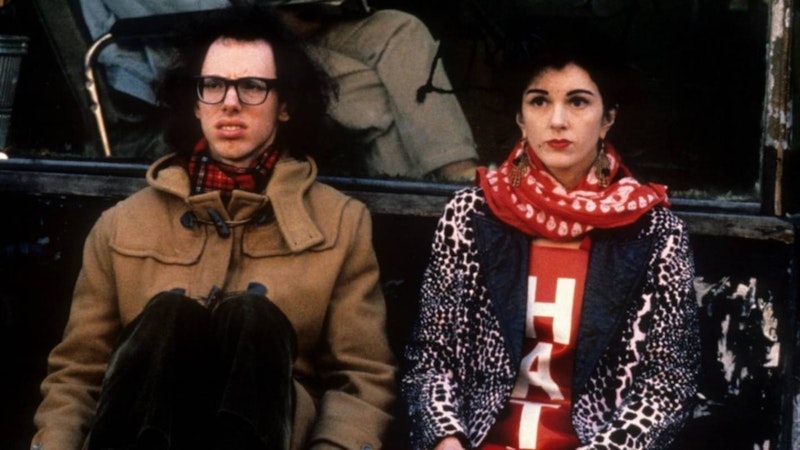Lynch, Waters, and…Todd Solondz. The director of Happiness, Welcome to the Dollhouse, Storytelling, and Palindromes hasn’t made a movie in eight years; Wiener-Dog came out years before Kieran Culkin and Greta Gerwig ascended to the Hollywood firmament. Although he hasn’t released anything, he’s remained in the public consciousness, his most famous films still rites of passage for any young person seriously interested in cinema. He’s supposedly making a film with Aubrey Plaza now, but who knows—that’s what they said about Waters! And now he gets miffed any time anyone asks about his Liarmouth, understandably frustrated after 20 years away and more relevant and popular than ever. For what it’s worth, I’m positive that a new film by John Waters would make millions more than one by Todd Solondz.
Waters didn’t start with Multiple Maniacs or Mondo Trasho—there’re a few early shorts he talks about, almost always listed in official filmographies: Hag in a Black Leather Jacket, Roman Candles, The Diane Linkletter Story, and Eat Your Makeup. When asked if he’ll ever screen them, he dismisses the films as juvenilia “that I don’t want anyone to see.” I doubt Richard Linklater would say the same of his debut It’s Impossible to Learn to Plow by Reading Books, but the leap from there to Slacker just a few years later is staggering. You can find that movie in the bonus features on the Slacker DVD, but you’ll never find Solondz’s 1989 debut Fear, Anxiety, Depression.
Can you find a file on the internet? Probably not worth the time. Do you have a tape player? Rent it if you like Solondz, and if you live near a great video store like Beyond Video in Baltimore. New York and LA can go fuck themselves, they’ll be able to see it on the repertory circuit, director disowning be damned. Fear, Anxiety, Depression isn’t talked about; Solondz never mentions it, and the widely-accepted narrative is he was simply part of the second wave of new independent American filmmakers in the first half of the 1990s. Welcome to the Dollhouse was a sensation that year, and 1998’s Happiness put him in the pantheon, at least for his generation of filmmakers. After 2001’s Storytelling, compromised by cold feet cutting after a year of festival screenings, Solondz hasn’t made a great movie; they’ve all been merely good. Apparently, he whittled Storytelling down so much because the gay frat James van Der Beek subplot (completely cut from the film) disturbed festival audiences so much; Selma Blair also said her superlative segment was originally “much longer;” another shame, because that’s the best performance of her career.
Maybe he was worried about censorship after October Films dumped Happiness and destroyed its theatrical rollout; even so, you don’t anticipate corporations, Disney, or the MPAA when you’re screening a finished or nearly-finished film at a major European film festival. He must’ve known there was no way he’d ever cross over with material like this, so it can’t be a commercial consideration—van Der Beek hadn’t even done The Rules of Attraction yet, so a gay frat bro was about as against type as you could get for the Dawson’s Creek star. Nevertheless, his scenes have never surfaced. Solondz has hid them away… just like his Fear, Anxiety, Depression.
It really is too bad Solondz disowned it, because he’s good in the lead. It’s a—who else?—Woody Allen-esque New York comedy about downtown freaks and neurotics. Solondz is very funny as the schlemiel, but he goes all out, full slapstick, and it’s not great, it’s not even very good, it’s just good. If he had never made anything else, Vinegar Syndrome might very well be putting out this “recently discovered” late-1980s city comedy. But knowing what he would go on to do, it’s a lot of fun to watch Solondz write, direct, and act in a screwball comedy. There’s a particularly funny and mean woman who comes out in a red leotard that just says “HATE” in big silver letters at one point; you could say Solondz is the benevolent, well-adjusted, maybe Philip Seymour Hoffman in Happiness just 10 years prior, just a bit more well-adjusted.
So find it if you can. Whatever files you might find are probably in better shape than the tape I watched, which is almost completely washed from years of regular use. It travelled from a video store in Philadelphia to Baltimore, but who knows how many places and people it’s visited since its release in the early 1990s? Solondz will never reissue it, but maybe production company Polygram (!) might.
—Follow Nicky Otis Smith on Twitter and Instagram: @nickyotissmith

